I have an active group of on-line students in the Getting Started class who are wrestling with wet-on-wet. Sometimes it seems to me the problem isn’t about technique, it is mental –
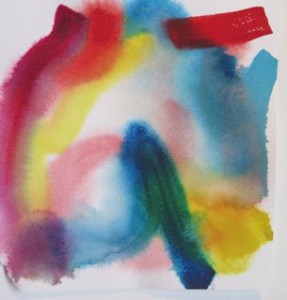 Gaining “control” by allowing things to happen.
Gaining “control” by allowing things to happen.
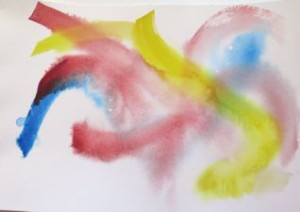 I am going to share some of my students’ paintings in order for you to let go of coloring things and learn how to become a collegue of wet on wet.
I am going to share some of my students’ paintings in order for you to let go of coloring things and learn how to become a collegue of wet on wet.
Look at these two paintings and decide which paper was wet all over and which was more wet on the right side…
Look for when one color dissolves into the edge of the next and when one intermingles with the next so that they create a new hue.
Look and decide where there was more paint on the brush (and what happened) and where there was less paint.
Where was there more water on the brush? Where was there less?
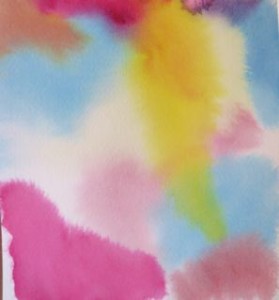 How did the artist save the light shape in the center of the top painting?
How did the artist save the light shape in the center of the top painting?
How is the mixing and blending of the colors on the right different from the ones in the top painting?
Follow the yellow on the right and see how many color changes it makes from top to bottom. Can you do that?
The students were concerned by the “feathers” or caterpillar edges they felt they got on a shape such as the blob of red in the lower left. Is that all right?
Well, it would be wouldn’t it, if it were the edge of a cat or dog, a teddy bear?
The pink next to it doesn’t have the feathers, nor does the blue. Only by doing do you learn how much water creates the one … or the other.
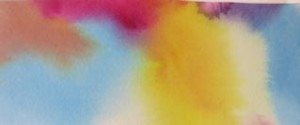 On the left is a close up of the top of the painting… There are exciting things happening here between the different colors of paint!
On the left is a close up of the top of the painting… There are exciting things happening here between the different colors of paint!
Look at the edge where the blue moves into the read and an electric violet occurs.
Look at the gold dissolving into the red; the red into a dull orange. THAT is watercolor. THAT is wet on wet.
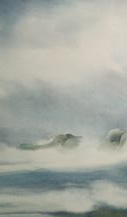 One of my students, after spending several days in concentrated work as well as ,”many many pieces of Arches paper ” felt that she was “getting it — how much water to have on my brush.”
One of my students, after spending several days in concentrated work as well as ,”many many pieces of Arches paper ” felt that she was “getting it — how much water to have on my brush.”
She was echoing my statements that you have to do it again and again before you begin to “feel” the right amount. She said she had been using too much paint, not letting things happen. She was getting it by doing… and doing.
As I said when we started:
Learn to appreciate what the paint does instead of trying to make an object. It is all right to go through lots of good watercolor paper and lots of good pigment to learn what happens when the paper is wet or not, what happens when there is more or less water on your brush and what happens when there is more or less paint on your brush along with that amount of water, as well as that amount of water on the paper.
It is how you learn to let the paint and the paper become your compatriots in telling your story.
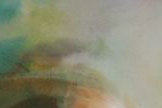
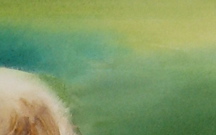
It only becomes real when you try it.
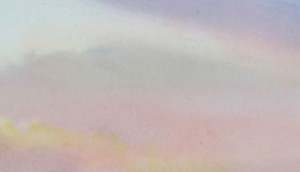 I am trying to learn to play Clair du Lune. I still am. I now have a recording. I don’t know if I will ever get it up to tempo. I am working on TWO MEASURES with 16th notes in the base. I have no idea how many times I have done them. Same thing.
I am trying to learn to play Clair du Lune. I still am. I now have a recording. I don’t know if I will ever get it up to tempo. I am working on TWO MEASURES with 16th notes in the base. I have no idea how many times I have done them. Same thing.
Going down the left side are cropped pieces from paintings showing wet-on-wet in action: surf and sky — soft edges, colors changing into other colors. Then two of the hair of Winky Pali and Callie Running. Both are of the hair dissolving into the background. Tougher in Callie because of the strong dark. You can see both of these in the Gallery sections, plus study other backgrounds that were obviously wet on wet.
Why Wet on Wet?
To set up your light areas by putting some kind of color down on the rest of the paper
To resolve the soft edges of clouds, surf, fur, etc.
To get undercolors or more resonant colors by layering one color over the other wet on wet.
To create out of focus areas
To create texture with splatter, wet lines and movement through the colors
To keep it fresh and looking like a watercolor.
It takes practice. It takes play… having fun, even making a “mess” and not judging. Just learning from what went wrong and trying it again. More water. Less water. How much paint?
![IMG_0356[1]](/wp-content/uploads/2016/04/IMG_03561-300x223.jpg)
On The Prowl
(one shot, wet on wet)
Or come paint on Orcas in May — hands on, with guidance. And lots of fun!!
